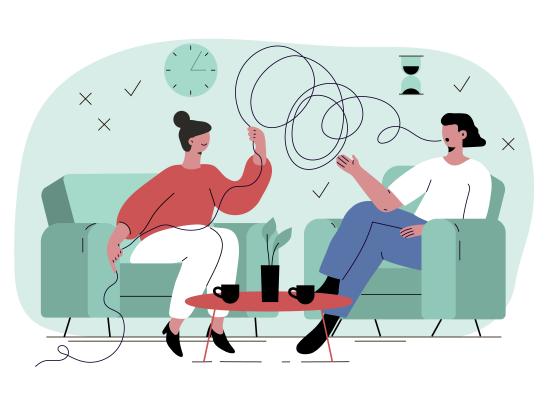Group Therapy for Hair Pullers
Online test
Find out the severity of your symptoms with this free online test
 Trichotillomania (TTM) is defined as recurrent pulling out of one’s hair, resulting in noticeable hair loss, which is not due to another medical condition. There is often, but not always, an increasing sense of tension strong urges immediately before pulling out the hair, or when attempting to resist the behavior, and pleasure, gratification or relief during and/or immediately after the act. While the Diagnostic and Statistical Manual (DSM5) only reccently recognized it as a clinical condition, recent researchers have proposed the phrase Body-Focused Repetitive Behavious (BFRB) to describe the full range of behaviors associated with trichotillomania. The most common examples are nail biting, cuticle biting and picking, skin picking, and other compulsive, excessive grooming behaviors. The treatment described here applies equally well to this full range of specific body focused problems. Trichotillomania is often related to other emotional disorders, such as anxiety disorder, worry & rumination, OCD and depression.
Trichotillomania (TTM) is defined as recurrent pulling out of one’s hair, resulting in noticeable hair loss, which is not due to another medical condition. There is often, but not always, an increasing sense of tension strong urges immediately before pulling out the hair, or when attempting to resist the behavior, and pleasure, gratification or relief during and/or immediately after the act. While the Diagnostic and Statistical Manual (DSM5) only reccently recognized it as a clinical condition, recent researchers have proposed the phrase Body-Focused Repetitive Behavious (BFRB) to describe the full range of behaviors associated with trichotillomania. The most common examples are nail biting, cuticle biting and picking, skin picking, and other compulsive, excessive grooming behaviors. The treatment described here applies equally well to this full range of specific body focused problems. Trichotillomania is often related to other emotional disorders, such as anxiety disorder, worry & rumination, OCD and depression.
Diagnosis
According to the DSM5, produced by the American Psychiatric Association and used by most mental health professionals in North America and Europe to diagnose mental disorders, the following conditions must be present for a diagnosis of trichotillomania:
- noticeable hair loss due to recurrent hair-pulling
- tension immediately before hair-pulling, or when attempting to resist hair pulling
- reduction of tension, or a feeling of pleasure or gratification, immediately following hair-pulling
- significant distress or impairment in social, occupational, or other important areas of functioning
In addition, the DSM-IV-TR requires that hair-pulling not be due to another medical or mental disorder. The tension release requirement is controversial because 17% of people who otherwise qualify for this diagnosis do not experience this. Symptoms usually emerge in early adolescence. Episodes may last a few minutes or a few hours during periods of stress or relaxation. Hairs with unique textures or qualities may be preferred. The pulling may include rituals, such as twirling hair off or examining the root. Half of those individuals with trichotillomania engage in oral behaviors running hair across the lips or through the teeth, biting off the root (trichophagy), or eating hair (trichophagia). The usually try to control their behavior in the presence of others and may hide the affected areas. Symptoms may come and go for weeks, months, or years at a time.
Causes
There is no known single or obvious cause, and there may be several contributing factors, such as genetic predisposition and stress. It is now commonly regarded as a medical illness, and it may be caused by a disruption in the system for communication between cells in the brain. People frequently start compulsive pulling at 12 to 13 years of age, although commonly at a much younger or older age. The onset may be associated with hormonal changes at puberty, although many people recall a significantly stressful event associated with the onset.
Lack of Awareness and Isolation
Due to the lack of awareness of the condition, trichotillomania often goes undiagnosed. People with trichotillomania often suffer alone for a long time without even knowing they have a clinically recognised condition. This contributes to feelings of loneliness, not being aware that so many others share the same daily struggles. Feeling like you are the only one leads to the individual feeling ashamed to confide in others or seek medical help, therefore suffering in silence. Constant hair pulling, whether of the scalp, the eyelashes, brows or any other bodily hair that eventually leads to balding or thinning can be a huge source of embarrassment. This may lead to the individual avoiding situations where the affected areas will be visible to others such as wet or windy conditions. Inevitably this leads to a decreased participation in social activities, further isolating the person from his/her peer group. One study which sought to clarify the nature and types of problems experienced by trichotillomania patients and its interrelatedness, found that a large number avoided public and social activities such as haircuts or sexual activities.
Group Therapy can Help
While many approaches claim to help example, hypnosis, only Cognitive-Behavior Therapy (CBT) is associated with supportive evidence from scientific studies. CBT involves identifying and modifying the patterns that lead to hair pulling. Through careful practice and professional coaching, the urges to pull may be effectively resisted and gradually subside. The treatment may also involve group therapy, and/or training in life skills such as assertiveness, anger/anxiety and stress management, goal setting, problem solving and relaxation. Programs are usually tailored to the needs of the individual and, where practical, involve the family and supportive others. Improved life skills and developing healthier alternative coping mechanisms are intended to address the underlying causes for hair pulling. A sense of community is a powerful force for healing with many people – to know that you are not alone; to discover after years, or even decades, that your condition is known to medicine; to share your thoughts and feelings; to feel understood and accepted; to see people, who share the same affliction, caring for one another, the process of sharing your journey can be very cathartic.

Pros and Cons of Group Therapy
The clear advantage of group therapy over the traditional individual patient-therapist relationship is the leveraging of multiple relationships to assist individual growth and problem solving. Group therapy can be a powerful agent of change through some of the “curative factors” identified by psychiatrist Dr. Irvin D. Yalom.
- Instillation of hope: Watching others cope with skin picking disorder and overcome similar problems successfully instils hope and inspiration.
- Universality: Group therapy provides people struggling with skin picking with a feeling of being understood and being similar to others. Enormous relief often accompanies the recognition that you are not the only one struggling with the disorder.
- Altruism: People with skin picking disorder often feel shame and guilt at not having control over the behaviours. The process of helping others is a powerful therapeutic tool that greatly enhances one’s self-esteem and feeling of self-worth.
- Group cohesiveness: Belonging, acceptance, and approval are among the most important and universal of human needs. Group therapy can help someone struggling with skin picking disorder to feel truly accepted and valued for the first time. Another advantage of group therapy is that is a much less expensive option than individual therapy.
 Of course for the power of groupwork to be harnessed the individual must be able ready to speak openly in front of others. For some this can be extremely challenging regardless of the sense of shared struggle. This is particularly difficult if one of the underlying causes on hair pulling is related to anxiety of social phobia. These individuals would struggle to engage in a group setting. There is also the risk and fear that members of the group may break confidentiality and this may hinder the level individuals are willling to share within the group space. It is important to note that, regardless of the mode of intervention, improvement tends to be gradual and incremental rather than all-or-none. It is helpful to gauge improvement by all aspects of the person’s overall quality of life. Different people respond differently to different types of therapy. It may even be that a combination of group therapy and other modalities may be neccessary
Of course for the power of groupwork to be harnessed the individual must be able ready to speak openly in front of others. For some this can be extremely challenging regardless of the sense of shared struggle. This is particularly difficult if one of the underlying causes on hair pulling is related to anxiety of social phobia. These individuals would struggle to engage in a group setting. There is also the risk and fear that members of the group may break confidentiality and this may hinder the level individuals are willling to share within the group space. It is important to note that, regardless of the mode of intervention, improvement tends to be gradual and incremental rather than all-or-none. It is helpful to gauge improvement by all aspects of the person’s overall quality of life. Different people respond differently to different types of therapy. It may even be that a combination of group therapy and other modalities may be neccessary
Online test
Find out the severity of your symptoms with this free online test
Start your journey with TrichStop
Take control of your life and find freedom from hair pulling through professional therapy and evidence-based behavioral techniques.
Start Now



